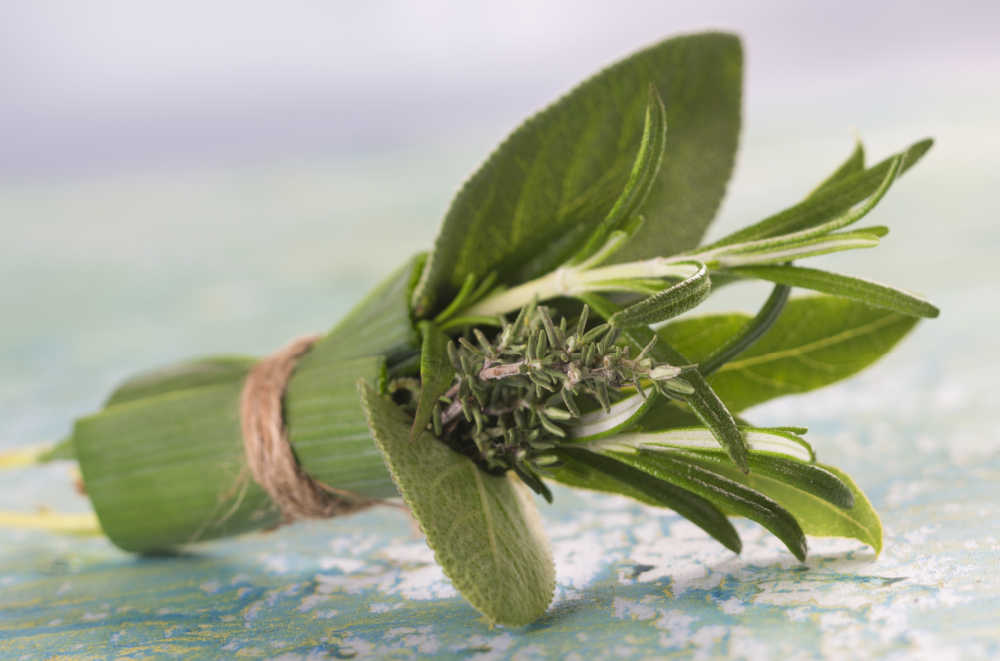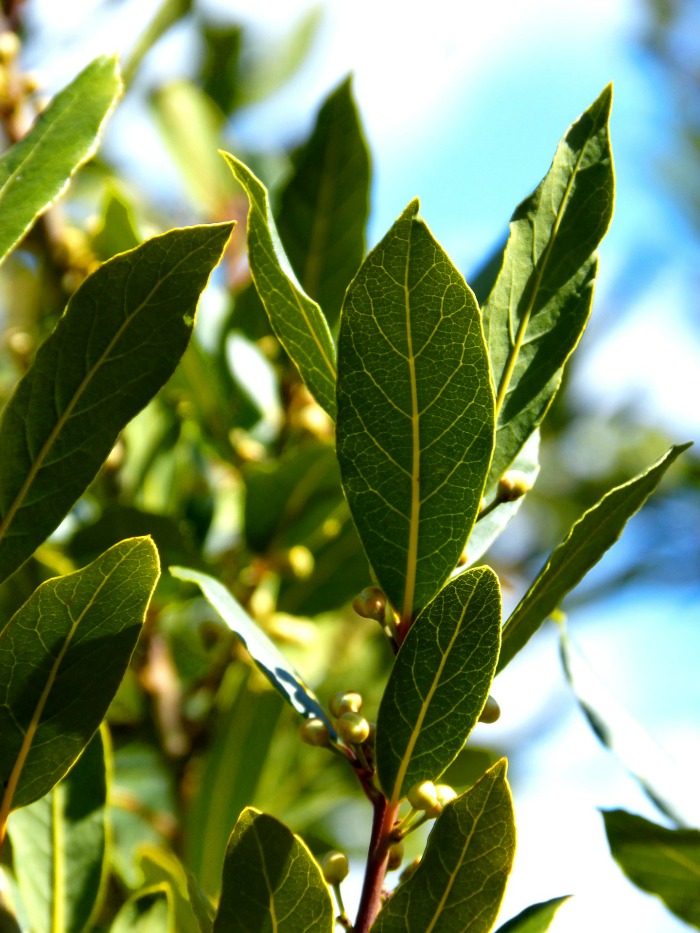Bay Leaf plants are slow growing trees with leaves that are used as seasoning in cooking. It is also known as bay laurel, sweet bay and simply laurel.
If you enjoy growing herbs, this is a great one to try, since it has a very aromatic flavor.
Bay leaf plants are a member of the family lauraceae. These trees are native to the Mediterranean region and the leaves are often used in Mediterranean recipes.
Instead of grinding the spices, even when dried, the leaves are used whole in recipes. You can even freeze the leaves to use all winter long.
Bay Laurel was considered a sacred plant to the Greeks and Romans. Trees were often planted near temples and the foliage was burned during various rites.

If you enjoy cooking stews and casseroles, your recipe may call for a bouquet garni.
This is a bunch of herbs (traditionally thyme, sage and bay leaf – sometimes rosemary and tarragon too) tied in a bundle and added to the liquid to flavor it.

Growing bay leaf plants
Have you ever seen a pot of beef stew or a hearty soup with a large leaf in the middle of the mixture? You are looking at a bay leaf.
This herb adds a robust flavor to soups and stews and has long been used as a seasoning in cooking.

Bay Leaf plants are tolerant of most soil types. Ideal PH range is 6-7, but the plant is somewhat versatile and can stand a range of 4.5 to 8.3.
What it will not tolerate is soil that does not drain well. Applications of compost or other organic matter will help to keep the soil draining well.
Size of bay leaf plants
Bay Laurel can be grown indoors in pots, and outdoors as shrubs and also as trees. It is a slow growing plant and can reach heights of 59 feet in the conditions are right.
Although the plant is a tree at heart, it can be kept smaller by pruning the plant or growing it in containers near your vegetable garden.
Container grown plants will not get to this large size. Prune it so that it gets no taller than 5-6 feet so that you can move it indoors when the weather gets colder.

Sunlight and moisture conditions for bay laurel
The plant grows best in full sun to partial shade. If you grow it outdoors in hot climates, it will benefit from some afternoon shade.
If you grow the plant indoors, it will need bright light and the occasion misting to keep the humidity level as the plant likes it.
Trees grown outside don’t generally need much in the way of fertilizer but container plants will benefit from a balanced organic fertilizer such as fish emulsion in the spring and summer.

Flowers and leaves of bay leaf plants
Bay trees are dioecious, which means that both male and female plants are needed to produce seeds that are viable. The seeds form on the female plants and are contained inside the berries that form in the fall.
Each female flower has a single seed.
Female plants have flowers with only a pistil. Male plants have flowers with only stamens. Only the female bay laurel plants will bear fruit.
Bay leaf plants have small yellow flowers that appear in the spring. These mature over the summer and develop into blackish purple berries in the fall which contain one seed.
If you grow it as a hedge and prune it often, you will have less in the way of flowers and berries.
The flowers of bay leaf are quite showy. They start as small buds and open into clusters. The plant smells sweet when flowering but the leaves are quite pungent.

How to grow bay laurel
Hardiness zones for bay leaf plants
Bay Laurel is hardy in zones 7-10. In colder zones, it is very frost sensitive, but can be grown in a pot and brought indoors for the winter, or kept in a sheltered closed area where the extremes of the cold won’t kill it.
It can only take temperatures down to about 20 degrees F.
In warmer zones, the plant is considered a perennial.
Drying bay leaves
Bay leaves can be used whole or ground in cooking. Harvest leaves from plants at least 2 years old. (Mature bay leaves have more flavor.)
To dry the leaves, place them on parchment paper on a large tray in a single layer. Leave them for 2 weeks in a warm dry room.
Store bay leaves whole in an air tight container. You can also grind them in a mortar and pestle if you wish, but I always use bay leaves whole.
Dried bay leaves are very fragrant and do not disintegrate during the cooking process. They are removed before eating the cooked recipe.
Check out this post to learn several other ways to dry bay leaves.
Ways to grow bay leaf plants
In warmer zones, grown bay laurel as a tree. It can used in topiary to create ball shaped plants. The stems are also grown twisted and they are grown as hedges, too.
Since bay is only hardy to zone 8, Bay Laurel is often grown as a houseplant in colder zones. For best results re-pot a container plant every 2-3 years

Pest and diseases that affect bay laurel
Thankfully, bay laurel is resistant to most pests and diseases. Weak plants can attack scale and aphids.
Treat infected plants with an organic pesticide. Common problems with bay leaf plants is simple over-watering, cold temperatures and lack of sunlight.
Propagation of bay leaf plants
The plants take a long time to germinate from seed. Normal plant propagation is from cuttings or air layering.
The cuttings need to root in a heated propagator with high humidity. It’s quite difficult to propagate.
Other uses of bay leaves
In addition to using bay leaves in recipes, they are also used in many other ways. The extract of bay laurel has been used in astringents and even as a treatment for open wounds.
Bay leaves soaked in water and formed into a poultice has often been used to treat poison ivy, and other poisonous plants.
Bay leaves and extracts are often used in massage therapy and aromatherapy to give some relief from of symptoms of arthritis and high blood pressure.
The leaves of bay laurel plants have long been used to make wreaths, garlands and crowns.
It is common to see the shape of a laurel crown on trophies. In early Greek and Roman times, crowns were created with stems of the plant to crown the athletes and rulers. 
Pin these plants for growing bay leaves for later
Would you like a reminder of this post for how to grow bay laurel? Just pin this image to one of your gardening boards on Pinterest.

Admin note: this post for growing bay laurel first appeared on the blog in December of 2017. I have updated the post to add new photos, a printable growing tips card, and a video for you to enjoy.
How to Grow Bay Leaf Plants (Bay Laurel)

Bay leaves are dried to use in recipes from soups to stews and more. See how to grow it in your back yard.
Materials
- Bay leaf plant
- Organic matter or compost
Tools
- Watering can or hose
- Spade
Instructions
- Choose a spot that gets full sun to partial shade.
- Dig a hole and add compost or other organic matter.
- Place the bay leaf plant in the hole, water well and keep evenly moist.
- Be sure the soil drains well.
- Fertilize in spring and summer in following years.
- Bay plants will grow tall outdoors. If growing in a pot, prune to 5-6 feet.
- Hardy in zones 7 to 10. (will only take the cold down to 20 degrees F.)
- Propagate by cuttings or air layering.
- Flowers emerge in spring and turn to berries in the fall.
- Generally pest free, Weak plants may attract aphids or scale,
Chibuike
Friday 28th of April 2023
I am no way to get Bay leave
Stuart Lewine
Monday 4th of April 2022
I was riding my bike the other day and I think I found a bay leaf tree. How do attach a picture so that someone might be able to help confirm and possibly identify what I saw?
Carol Speake
Monday 4th of April 2022
The site no longer does plant identification for individuals. Google has many photos of bay plants with photos to check.
JanJan
Sunday 3rd of April 2022
Why is there a two year wait time before bay leaf can be use for cooking?
Carol Speake
Sunday 3rd of April 2022
They can be used prior to two years, but mature bay leaves have more flavor.
Ernesto Pantua Jr
Monday 30th of August 2021
Thanks a lot for the very informative post on how to grow bay leaf. I am from the Philippines and hope to be successful in planting this herb.
Summer
Sunday 8th of August 2021
Do you have the turkeys bay leaf plants? It has big leafs